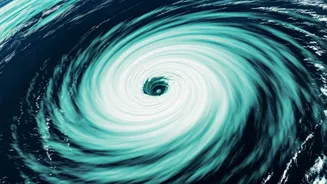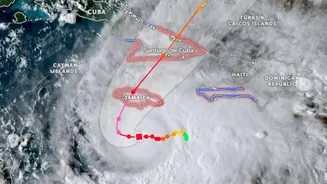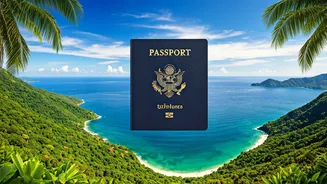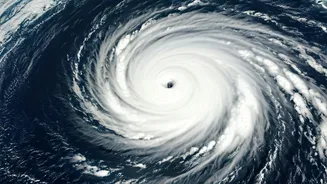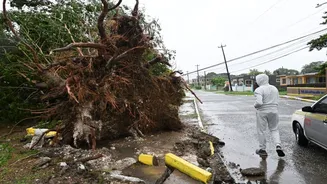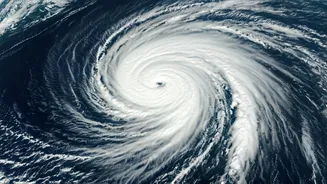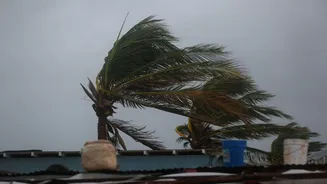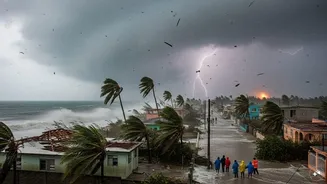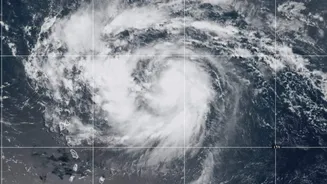Storms: Key Differences
Hurricanes, cyclones, and typhoons are essentially the same phenomenon, differing mainly in their geographical location. All three are powerful, rotating
storm systems characterized by low pressure, strong winds, and heavy rainfall. A storm is called a hurricane when it occurs over the Atlantic Ocean and the northeastern Pacific Ocean. The same type of storm is referred to as a typhoon in the northwestern Pacific Ocean. When the storm forms in the South Pacific Ocean or the Indian Ocean, it's called a cyclone. Despite the varying names, all of these storms are born from similar atmospheric conditions involving warm ocean waters and converging winds, resulting in significant wind speeds that cause substantial damage.
What Makes a Hurricane?
Hurricanes originate over warm ocean waters near the equator, where the sea surface temperature is typically at least 80 degrees Fahrenheit (26.5 degrees Celsius). This warm water provides the necessary energy and moisture to fuel the storm. The process begins when warm, moist air rises from the ocean's surface, creating an area of lower pressure below. As this air rises, it cools and condenses, forming towering thunderstorms. The Earth's rotation, the Coriolis effect, causes these thunderstorms to start rotating. If these conditions persist, the storm intensifies, with sustained winds increasing and a defined eye forming. The eye of the hurricane, the calm center, can reach a diameter of several miles. As the hurricane moves over land or cooler waters, it loses its energy source and starts to weaken.
Category 1: Dangerous Winds
Category 1 hurricanes are characterized by sustained wind speeds ranging from 74 to 95 mph (119 to 153 km/h). Such winds can inflict damage, including peeling off roof coverings, damaging poorly constructed buildings, and uprooting trees. There's potential for flooding from storm surges, especially in coastal areas. Some coastal roads and piers may become inundated. Despite the danger, Category 1 hurricanes are often manageable, as people can take steps like securing loose objects, evacuating if necessary, and staying informed about the storm's progress. It's important to remember that even a Category 1 hurricane can cause significant damage and disruption, particularly to vulnerable infrastructure and communities.
Category 2: Extensive Damage
Category 2 hurricanes see sustained wind speeds of 96 to 110 mph (154 to 177 km/h). At this level, damage becomes more widespread. Well-constructed buildings can experience roof and siding damage, while poorly built structures face substantial destruction. Numerous trees are likely to be uprooted, blocking roads and potentially causing power outages that can last for days or weeks. Significant flooding is a common occurrence. The impact of a Category 2 hurricane can be severe, resulting in significant economic losses and a disruption of daily life. Evacuation orders are typically issued for those in vulnerable areas, underscoring the serious risk these storms present.
Category 3: Major Hurricane
A Category 3 hurricane is officially classified as a 'major hurricane', with sustained winds reaching 111 to 129 mph (178 to 208 km/h). Significant structural damage occurs at this intensity, with well-built homes possibly suffering damage to their roofs and walls. Many trees are uprooted, and electricity is likely to be cut off, with widespread outages that can persist for extended periods. Low-lying areas can be flooded, causing significant destruction. Coastal communities may experience substantial damage from storm surge and waves, leading to the destruction of some smaller buildings. Category 3 hurricanes pose a major threat and necessitate extensive preparations, including mandatory evacuations in high-risk zones.
Category 4: Catastrophic Power
Category 4 hurricanes pack sustained winds from 130 to 156 mph (209 to 251 km/h), resulting in a considerable amount of structural damage. Well-built structures face severe damage, with major roof and wall collapses. Most trees are uprooted, and power outages are typically widespread, often lasting for weeks or months. Significant inland flooding is probable, causing widespread property damage. Storm surges can cause considerable destruction along coastlines, with potential for extensive damage or destruction to structures. These storms pose a severe threat, prompting comprehensive evacuation strategies and potentially requiring extensive disaster relief and recovery efforts. The impact of a Category 4 hurricane is substantial, creating long-term challenges for the affected communities.
Category 5: The Extreme
Category 5 hurricanes are the most intense storms, with sustained winds exceeding 157 mph (252 km/h). They cause catastrophic damage. Complete roof failure and wall collapse of many homes and industrial buildings are typical. Massive tree uprooting and nearly complete power failure is inevitable. Extensive flooding and storm surge result in destruction of low-lying areas, with potential for devastation of entire coastal areas. Category 5 hurricanes are extremely rare, but they pose the most extreme threat, leading to total destruction, significant loss of life, and requiring long-term recovery efforts. The impact of such a storm is felt for years, leaving lasting effects on the environment, economy, and society.
Is There A Category 6?
Currently, the Saffir-Simpson Hurricane Wind Scale only classifies hurricanes up to Category 5. There is no official Category 6 for hurricanes. This scale was designed to classify hurricanes based on their wind speed. While the possibility of a Category 6 storm has been discussed, the scale's current structure effectively covers the spectrum of hurricane intensities observed, with Category 5 already indicating the most extreme and catastrophic levels of damage. It is a tool for meteorologists and emergency managers to assess the potential impacts of a hurricane and prepare for its arrival. While discussions regarding the development of a Category 6 are ongoing among meteorologists, the current scale continues to be reliable in the evaluation of hurricanes.
Global Pattern Of Storms
The global pattern of storms is linked to several factors, including sea surface temperatures, atmospheric conditions, and the Earth's rotation. Hurricanes, typhoons, and cyclones form over warm ocean waters near the equator, with sea surface temperatures of at least 80 degrees Fahrenheit (26.5 degrees Celsius). The Coriolis effect plays a vital role, causing storms to rotate. Storms generally develop away from the equator because the Coriolis effect is weak or non-existent in this area. Seasonal patterns also impact storm formation; for example, the hurricane season in the Atlantic peaks from August to October. Changes in the climate can affect these patterns, potentially leading to alterations in storm intensity and frequency. These factors influence the geographical distribution and timing of these powerful weather events.
How Hurricanes Cause Destruction?
Hurricanes cause destruction through several mechanisms. Strong winds are a primary cause of damage, toppling trees, damaging buildings, and causing widespread power outages. Storm surge, the rise in sea level associated with a hurricane, can cause extensive flooding along coastlines, inundating homes, and eroding beaches. Heavy rainfall can lead to flooding in both coastal and inland areas, causing significant property damage and disruption. In addition to these primary impacts, hurricanes can also trigger secondary effects, like landslides, tornadoes, and debris, which increase the overall impact. The combined effects of these elements can cause tremendous damage, resulting in significant economic losses, infrastructure damage, and danger to life. Understanding these factors is key to preparing for and responding to a hurricane.
